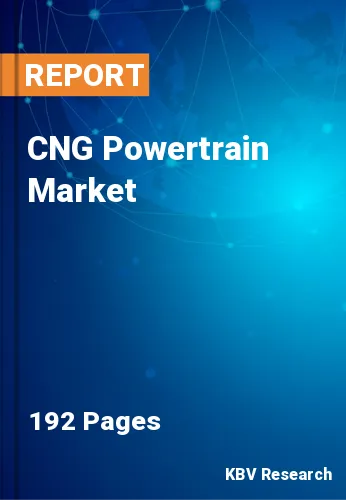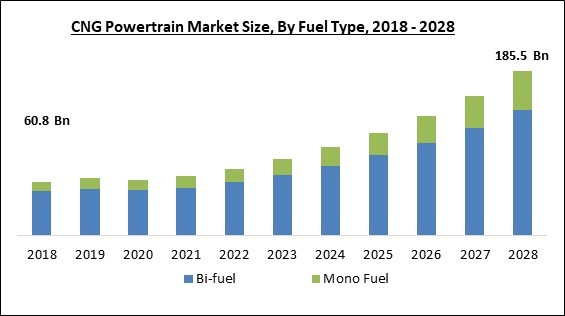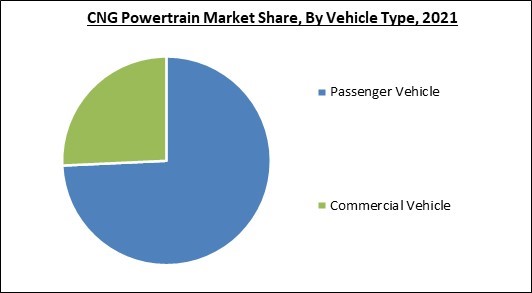
The Global CNG Powertrain Market size is expected to reach $185.5 billion by 2028, rising at a market growth of 16.2% CAGR during the forecast period.
The demand for an alternate transitional fuel is growing, leading to the aim of net-zero carbon emissions. Compressed Natural Gas (CNG) emits fewer carbon emissions and is free of particulate matter, which is a major source of vehicular pollution. As a result, CNG is predicted to overtake other fuels such as diesel, petrol, and LPG as a dominating energy source. Governments throughout various regions are implementing the strategic programs to provide tax subsidies, rebates, and other incentives to CNG vehicle buyers, resulting in increased demand for CNG powertrain vehicles over the forecast period.

Increased use of natural-gas cars can help countries with the own natural-gas sources become less reliant on liquid fuel imports. In many nations, natural-gas vehicles are also a cost-effective option because LNG and CNG are less expensive than gasoline or diesel. This cost advantage is especially beneficial for applications that use a lot of energy. Moreover, natural gas-powered commercial vehicles are substantially cleaner than those with traditional powertrains. For example, this means that natural-gas cars can be utilized for late-night deliveries in cities and towns. In light of this, policymakers and others are beginning to favour natural gas as a substitute fuel, allowing manufacturers to tap into hitherto untapped market niches.
Vehicles that run on compressed natural gas (CNG) are similar to those that run on gasoline and have spark-ignited internal combustion engines. The engine works similarly to a gasoline engine. Natural gas is kept in a fuel tank, or cylinder, usually in the vehicle's back. The CNG fuel system transports high-pressure gas from the fuel tank through the fuel lines to a pressure regulator, which lowers the pressure to a level compatible with the engine's fuel injection system. Finally, the gasoline is injected into the combustion chamber or intake manifold, where it is combined with air and compressed before being burned by a spark plug.
CNG is typically used for buses and trucks that travel to base on a regular basis for refueling. CNG is also utilized as a vehicle fuel. CNG vehicles must be refueled with specially designed compressors that are linked to a natural gas mains supply. Natural gas is kept in a fuel tank, or cylinder, usually in the vehicle's back. The CNG fuel system transports high-pressure gas from the fuel tank by the fuel lines to a pressure regulator, which lowers the pressure to a level suitable with the engine's fuel injection system.
The outbreak of COVID 19 had brought the entire ecosystem to a standstill, halting the production and sale of new automobiles. Manufacturers had to wait for the lockdowns to be released before the production could be resumed, which had a negative impact on the operations. As a result, automakers had to modify their manufacturing volumes. Component production was also halted, and small Tier 2 and Tier 3 manufacturers faced cash flow problems. The automotive industry is a high-capital-intensive industry that requires frequent financing to stay afloat. As a result, the production halt and lower demand during the pandemic had an extraordinary impact on the CNG Powertrain market.
CNG Powertrain have substantially lower operating costs than petroleum vehicles. Substitute fuels such as CNG & LPG are more cost-effective, especially for those who drive frequently. This is because, depending on how much the customer drives the vehicle, the upfront investment of CNG or LPG is readily recovered by the money saved in a few years. Petroleum costs have risen dramatically in recent years, whereas CNG and LPG prices have risen at a far slower rate. This could be a major factor in increasing the market share of CNG powertrain.
As many countries have become more concerned about increasing emissions, the proliferation of low-emission fuel cars such as CNG and LPG vehicles may accelerate. There are numerous countries that have stated their desire to cut emissions over the next several decades, and they are creating more requirements for these automobiles in the years ahead. Numerous countries have already aided the growth of substitute fuel vehicles such as CNG and LPG in order to reduce emissions and costs associated with the import of gasoline. Present vehicles can readily be converted to CNG or LPG fuel systems at a low cost.

CNG and LPG automobiles are more expensive than ordinary gasoline vehicles. This is owing to the additional components that have been added to these vehicles. As a consequence of the lack of lubricants in most of these vehicles, various sections of these vehicles get deteriorated faster than petrol vehicles i.e., parts that are more prone to overheating, these vehicles require considerably more routine maintenance over time and hence cost more in the long run. Moreover, compared to petrol vehicles, which typically have a longer lifespan than similar equipment, the parts must be updated on a regular basis.
Based on Fuel Type, the market is segmented into Bi-fuel and Mono Fuel. The Bi-fuel segment acquired the maximum revenue share in the CNG Powertrain market in 2021. The increased adoption of modern technologies such like S-CNG technology, which allows for easy changeover between gasoline and CNG without impacting engine performance, is credited with the segment's rise.
Based on Vehicle Type, the market is segmented into Passenger Vehicle and Commercial Vehicle. The Commercial Vehicle segment procured a substantial revenue share in the CNG Powertrain market in 2021. To lessen environmental degradation, more CNG-powered buses are being used for school and public transportation. These buses are eco-friendly, and they are projected to minimize traffic pollution in the city as a whole. As a result, such government measures in emerging nations are expected to enhance the adoption of CNG commercial vehicles and create need for CNG powertrain in the market.
Based on Drive Type, the market is segmented into Front Wheel Drive, All-wheel Drive, and Rear Wheel Drive. The Front-Wheel Drive segment witnessed the maximum revenue share in the CNG Powertrain market in 2021. The advantages of front wheel drive vehicles, such like lightweight, improved fuel economy, and vehicle weight distribution equilibrium, which improves the comprehensive stability of the vehicle in rough terrains, are contributing to the segment's growth.
| Report Attribute | Details |
|---|---|
| Market size value in 2021 | USD 67 Billion |
| Market size forecast in 2028 | USD 185.5 Billion |
| Base Year | 2021 |
| Historical Period | 2018 to 2020 |
| Forecast Period | 2022 to 2028 |
| Revenue Growth Rate | CAGR of 16.2% from 2022 to 2028 |
| Number of Pages | 202 |
| Number of Tables | 330 |
| Report coverage | Market Trends, Revenue Estimation and Forecast, Segmentation Analysis, Regional and Country Breakdown, Companies Strategic Developments, Company Profiling |
| Segments covered | Fuel Type, Vehicle Type, Drive Type, Region |
| Country scope | US, Canada, Mexico, Germany, UK, France, Russia, Spain, Italy, China, Japan, India, South Korea, Singapore, Malaysia, Brazil, Argentina, UAE, Saudi Arabia, South Africa, Nigeria |
| Growth Drivers |
|
| Restraints |
|
Based on Regions, the market is segmented into North America, Europe, Asia Pacific, and Latin America, Middle East & Africa. Asia Pacific emerged as the leading region in the CNG Powertrain market with largest revenue share in 2021. Many technological developments are taking place in Asia Pacific, as well as the development of CNG infrastructure. Leading regional companies, such as Maruti Suzuki, are implementing S-CNG technology into passenger vehicles like cars.
Free Valuable Insights: Global CNG Powertrain Market size to reach USD 185.5 Billion by 2028
The market research report covers the analysis of key stake holders of the market. Key companies profiled in the report include Maruti Suzuki India Limited, FPT Industrial (Iveco Group), Volvo Group, Honda Motor Co. Ltd., Cummins, Inc., Hyundai Motor Company, Volkswagen AG, Ford Motor Company, Bosch Rexroth AG (Robert Bosch GmbH), and Nissan Motor Corporation.
By Fuel Type
By Vehicle Type
By Drive Type
By Geography
The CNG powertrain market size is projected to reach USD 185.5 billion by 2028.
Lower operational cost in comparison to petroleum vehicles are driving the market in coming years, however, Excessive initial outlay and maintenance cost compared to petroleum vehicles limited the growth of the market.
Maruti Suzuki India Limited, FPT Industrial (Iveco Group), Volvo Group, Honda Motor Co. Ltd., Cummins, Inc., Hyundai Motor Company, Volkswagen AG, Ford Motor Company, Bosch Rexroth AG (Robert Bosch GmbH), and Nissan Motor Corporation.
The production halt and lower demand during the pandemic had an extraordinary impact on the CNG Powertrain market.
The Passenger Vehicle segment acquired maximum revenue share in the Global CNG Powertrain Market by Vehicle Type in 2021, thereby, achieving a market value of $132.2 billion by 2028.
The Asia Pacific market dominated the Global CNG Powertrain Market by Region in 2021, and would continue to be a dominant market till 2028; thereby, achieving a market value of $111.1 billion by 2028.
Our team of dedicated experts can provide you with attractive expansion opportunities for your business.
